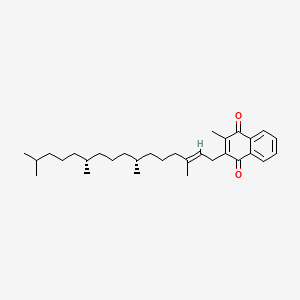Ferroptosis-centered Drug Response Information
General Information of the Drug (ID: ferrodrug0033)
| Name |
Vitamin K1
|
||||
|---|---|---|---|---|---|
| Synonyms |
Phylloquinone; Vitamin K1; phytonadione; 84-80-0; Phytomenadione; Phytylmenadione; 3-Phytylmenadione; Aquamephyton; Konakion; Phyllochinon; Mephyton; Monodion; Synthex P; Kinadion; Kephton; 2-Methyl-3-phytyl-1,4-naphthoquinone; Mono-Kay; Combinal K1; Kativ N; alpha-Phylloquinone; Fitomenadiona; K-Ject; Phyllochinonum; Phytomenadionum; Phytonadionum; trans-Phylloquinone; Aqua mephyton; VitaminK1; Antihemorrhagic vitamin; Fitomenadione; Vitamin K 1; 79083-00-4; 2',3'-trans-Vitamin K1; 2-Methyl-3-phytyl-1,4-naphthochinon; 11104-38-4; CHEBI:18067; Vitamin K1(20); UNII-S5Z3U87QHF; NSC 270681; Phylloquinone e-form; Aqua-Mephytin; Phythyl-menadion; VITAMIN K; 1,4-Naphthoquinone, 2-methyl-3-phytyl-; DTXSID8023472; HSDB 3162; 2-Methyl-3-(3,7,11,15-tetramethyl-2-hexadecenyl)-1,4-naphthalenedione; 2-methyl-3-[(2E,7R,11R)-3,7,11,15-tetramethylhexadec-2-en-1-yl]naphthalene-1,4-dione; EINECS 201-564-2; NSC-270681; S5Z3U87QHF; 2-methyl-3-[(E,7R,11R)-3,7,11,15-tetramethylhexadec-2-enyl]naphthalene-1,4-dione; DTXCID003472; MLF3D1712D; Phytonadione, (E)-(+/-)-; 1,4-Naphthalenedione, 2-methyl-3-(3,7,11,15-tetramethyl-2-hexadecenyl)-, (R-(R*,R*-(E)))-; 1,4-Naphthalenedione,2-methyl-3-[(2E,7R,11R)-3,7,11,15-tetramethyl-2-hexadecen-1-yl]-; 1,4-Naphthalenedione, 2-methyl-3-(3,7,11,15-tetramethyl-2-hexadecenyl)-; 2-Methyl-3-((7R,11R,E)-3,7,11,15-tetramethylhexadec-2-en-1-yl)naphthalene-1,4-dione; Orakay; 2-Methyl-3-[(2E)-3,7,11,15-tetramethyl-2-hexadecenyl]naphthoquinone; 2-Methyl-3-phythyl-1,4-naphthochinon; 1,4-Naphthalenedione, 2-methyl-3-((2E,7R,11R)-3,7,11,15-tetramethyl-2-hexadecenyl)-; CAS-84-80-0; rel-2-Methyl-3-((7R,11R,E)-3,7,11,15-tetramethylhexadec-2-en-1-yl)naphthalene-1,4-dione; Phytonadione, K1; 1,4-Naphthalenedione, 2-methyl-3-(3,7,11,15-tetramethyl-2-hexadecenyl)-, [R-[R*,R*-(E)]]-; 2-methyl-3-[(2E,7R,11R)-3,7,11,15-tetramethylhexadec-2-en-1-yl]-1,4-dihydronaphthalene-1,4-dione; Vitamin K-1; Phytonadione [USP:JAN]; Kanavit; Neokay; a-Phylloquinone; Konakion mm; NSC270681; vitaminum k1; 2-Methyl-3-((2E)-3,7,11,15-tetramethyl-2-hexadecenyl)naphthoquinone; Konakion mm paed; (E)-phytonadione; 2-methyl-3-((2E,7R,11R)-3,7,11,15-tetramethylhexadec-2-en-1-yl)naphthalene-1,4-dione; 2-methyl-3-((7R,11R,E)-3,7,11,15-tetramethylhexadec-2-enyl)naphthalene-1,4-dione; NCGC00159423-02; EINECS 234-330-3; EINECS 279-052-3; MFCD00214063; vitamin K1, 11; Vitamin K1 ,(S); VEDA-K1; VETA-K1; PHYTONADIONE [JAN]; phylloquinone;2-METHYL-3-PHYTYL-1,4-NAPHTHOQUINONE; Phylloquinone;Phytomenadione; SCHEMBL3882; 2',3'-trans-phylloquinone; Phythyl-menadion (GERMAN); Vitamin K1 (Phylloquinone); Vitamin K1, viscous liquid; CHEMBL1550; UNII-MLF3D1712D; PHYTONADIONE, (E)-; PHYLLOQUINONE, (E)-; MLS001074732; BIDD:GT0793; PHYTOMENADIONE, (E)-; PHYTONADIONE (USP-RS); SCHEMBL351365; 2', 3'-trans-Vitamin K1; PHYTOMENADIONE (MART.); 2-Methyl-3-[(2E)-3,7,11,15-tetramethyl-2-hexadecenyl]naphthoquinone #; -2-enyl)naphthalene-1,4-dione; BDBM24782; B02BA01; [r-[r*,R*-(E)]]-2-Methyl-3-(3,7,11,15-tetramethyl-2-hexadecenyl)-1,4-napthalenedione; [r-[r*,R*-(E)]]-2-Methyl-3-(3-7,11,15-tetramethyl-2-hexadecenyl)-1,4-naphthalenedione; PHYLLOQUINONE E-FORM [MI]; HMS2094G09; HMS2270J10; Pharmakon1600-01505485; HY-N0684; PHYTOMENADIONE (EP IMPURITY); PHYTONADIONE (USP MONOGRAPH); Tox21_111655; BDBM50553259; LMPR02030028; NSC760373; s4698; 2-Methyl-3-phytyl-1,4-napthoquinone; AKOS015841892; Tox21_111655_1; A034SE7857; CCG-213568; CS-6376; DB01022; NSC-760373; (R*,R*-(E))-(1)-2-Methyl-3-(3,7,11,15-tetramethylhexadec-2-enyl)-1,4-naphthoquinone; NCGC00159423-03; Phylloquinone (K1), analytical standard; AC-34846; AS-13734; SMR000112043; SBI-0206926.P001; trans-Phytomenadione 100 microg/mL in Ethanol; AB00698065_04; A840928; EN300-22411510; Q186093; SR-05000001941; C31H46O2 (2-methyl-3-phytyl-1,4-naphthoquinone); Q-201934; SR-05000001941-1; W-108488; Z2568644345; 2-methyl-3-((7R,11R,E)-3,7,11,15-tetramethylhexadec; 84C51B31-3CE2-476B-BE66-A84BDD46A513; VITAMIN K1; 2-METHYL-3-PHYTYL-1,4-NAPHTHOQUINONE; Phytomenadione, European Pharmacopoeia (EP) Reference Standard; Phytonadione, United States Pharmacopeia (USP) Reference Standard; 2-Methyl-3-(3,7,11,15-tetramethyl-2-hexadecenyl)-1,4-naphthalened- ione; Vitamin K1, BioXtra, >=99.0% (sum of isomers, HPLC), mixtur of isomers; 1,4-Naphthalenedione, 2-methyl-3-((2E,7R,11R)-3,7,11,15-tetramethyl-2-hexadecen-1-yl)-; 2-Methyl-3-((2E,7R,11R)-3,7,11,15-tetramethylhexadec-2-en-1-yl)-1,4-naphthoquinone; Phytonadione, Pharmaceutical Secondary Standard; Certified Reference Material; 1,4-NAPHTHALENEDIONE, 2-METHYL-3-((2E,7R,11R)-3,7,11,15-TETRAMETHYL-2-HEXADECEN-1-YL)-, REL-; 2-METHYL-3-((2E,7R,11R)-3,7,11,15-TETRAMETHYL-2-HEXADECENYL)-1,4-NAPHTHALENEDIONE; 2-methyl-3-[(E,7R,11R)-3,7,11,15-tetramethylhexadec-2-enyl]naphthalene-1,4-dione;Vitamin K1; MIXTURE OF THE TRANS (E) AND CIS (Z) ISOMERS CONTAINING NOT LESS THAN 75% OF TRANS-PHYTOMENADIONE
Click to Show/Hide
|
||||
| Status |
Approved
|
||||
| Drug Type |
Small molecular drug
|
||||
| Structure |
 |
||||
| Formula |
C31H46O2
|
||||
| IUPAC Name |
2-methyl-3-[(E,7R,11R)-3,7,11,15-tetramethylhexadec-2-enyl]naphthalene-1,4-dione
|
||||
| Canonical SMILES |
CC1=C(C(=O)C2=CC=CC=C2C1=O)CC=C(C)CCCC(C)CCCC(C)CCCC(C)C
|
||||
| InChI |
InChI=1S/C31H46O2/c1-22(2)12-9-13-23(3)14-10-15-24(4)16-11-17-25(5)20-21-27-26(6)30(32)28-18-7-8-19-29(28)31(27)33/h7-8,18-20,22-24H,9-17,21H2,1-6H3/b25-20+/t23-,24-/m1/s1
|
||||
| InChIKey |
MBWXNTAXLNYFJB-NKFFZRIASA-N
|
||||
| PubChem CID | |||||
| TTD Drug ID | |||||
Full List of Ferroptosis Target Related to This Drug
Long-chain-fatty-acid--CoA ligase 4 (ACSL4)
| In total 1 item(s) under this Target | |||||
| Experiment 1 Reporting the Ferroptosis-centered Drug Act on This Target | [1] | ||||
| Target for Ferroptosis | Driver | ||||
| Responsed Disease | Acute kidney failure | ICD-11: GB60 | |||
| Pathway Response | Fatty acid metabolism | hsa01212 | |||
| Cell Process | Cell ferroptosis | ||||
| In Vitro Model | NIH3T3 cells | Normal | Mus musculus | CVCL_0594 | |
| HT-1080 cells | Fibrosarcoma | Homo sapiens | CVCL_0317 | ||
| MCT (Murine proximal tubular epithelial cells) | |||||
| In Vivo Model |
All mice used in our in vivo studies were 8-week-old males of the C57BL/6J background. Kidneys were exposed via a midline abdominal incision and bilateral renal pedicle clamping for 35 min using microaneurysm clamps (Aesculap Inc., Center Valley, PA, USA). Throughout the surgical procedure, the mice were kept under isoflurane narcosis, and their body temperature was maintained at 36-37 by continuous monitoring using a temperature-controlled, self-regulated heating system (Fine Science Tools, Heidelberg, Germany). After clamps were removed, kidney reperfusion was confirmed visually before the abdomen was closed in two layers using standard 6-0 sutures. To maintain fluid balance, all mice were supplemented with 1 ml of prewarmed PBS administered intraperitoneally directly after surgery. After 48 h of reperfusion, the mice were sacrificed, blood samples were obtained by retrobulbar puncture, and kidneys were collected for analysis.
Click to Show/Hide
|
||||
| Response regulation | Renal expression of ACSL4 was markedly enhanced by IRI and reduced by vitamin K1. Vitamin K1 as a potent inhibitor of ferroptosis, and hence, it represents a potential drug for the treatment of pathological cell death processes during acute kidney injury in humans. | ||||
